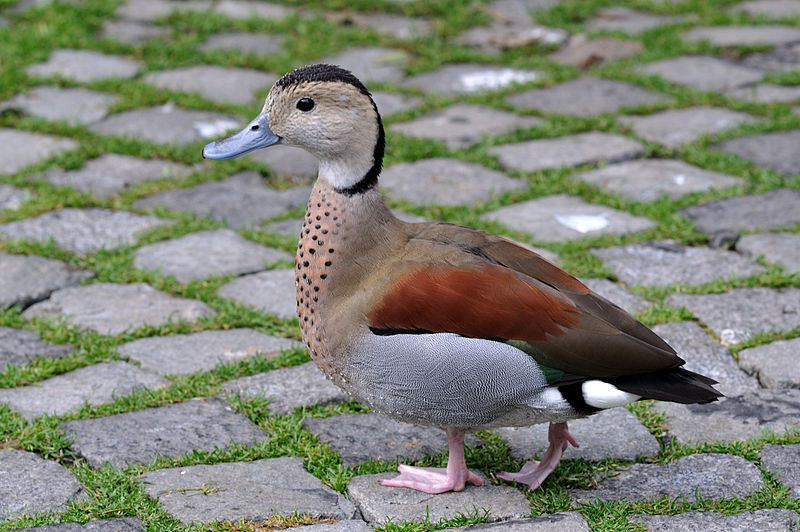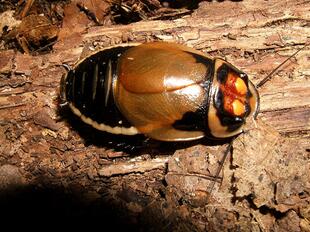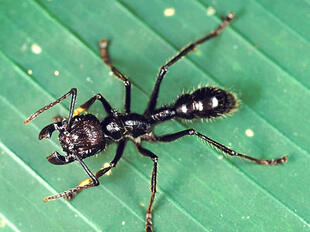
Ringed teal(Callonetta leucophrys)
Phylum —chordata
Class — aves
Order — anseriformes
Family — anatidae
Genus –callonetta
Appearance
The male and female remain colorful throughout the year, lacking an eclipse plumage. The drake has a rich chestnut back, pale grey flanks and a salmon-colored breast speckled in black. A black band runs from the top of its head down to the nape. Females have an olive-brownish back with the head blotched and striated in white, with penciled barring on a pale chest and belly. Both have a dark tail, a contrasting pale rump, and a distinctive white patch on the wing. Bills are grey and legs and feet are pink in both sexes.
Most ringed teals average 14–15 inches (36–38 cm) long, with a 28-inch (71 cm) wingspan. Individuals typically weigh 11–12 ounces (310–340 g).
Ringed teals also have webbed toes with long, pointed claws that specialize in allowing the birds to sit on tree branches. These specialized toes are unique, as most waterfowl cannot easily remain perched on tree branches.
Habitat
The ringed teal is native to Paraguay, Uruguay, northern Argentina and southern Brazil.
Diet
As a predominately aquatic species, ringed teals eat a variety of aquatic plants and invertebrates, as well as any seeds that can be found.
Reproduction
Upon reaching sexual maturity, ringed teals form strong pair bonds. These pair bonds typically last a single breeding season, but can last for the lifetime of a pair. A pair bond begins with the male courting the female. In general, courting consists of large amounts of preening, flashing the iridescent green patches on the wings, and swimming in figure eights around the female of interest while vocalizing. Once a pair bond is solidified, mating occurs in the water. Nests are usually created out of hollow holes in tree cavities. The nests are lined with down and the female tends to be the defender of the nest. The male, however, will defend the female against other males and potential predators throughout their pair bond.
Females typically lay 6-12 eggs that are white in color. The eggs are incubated for an average of 29 days. Both male and female participate incubating the eggs. Hatched chicks are precocial. Precocial chicks are mostly developed upon hatching, have a layer of down feathers, can walk, function, and essentially feed themselves. Although, the chicks hatch with a layer of feather down, it is not waterproof. Since the chicks spend most of their time in the water, they rub on the parents, in doing so, they gain essential oils needed for waterproofing. Both the male and female play a large role in raising and defending the chicks until they fledge at 50–55 days old. The male, however, tends to be the most invested and will often be seen following behind separated or slower chicks. Until fledging, the chicks stay in a close group and learn quickly from their parents how to forage, swim efficiently, and avoid predators. Often, the bonded pair is able to produce two groups of offspring in one breeding season. The male will continue to care for the first group of chicks, while the female incubates the second group of eggs. The ringed teal's pair bonding behavior makes reproduction very efficient. By the end of a breeding season it is possible for a bonded pair to have laid and hatched up to 24 offspring.
In captivity
Ringed teals can live up to 15 years in captivity.
Ducks feel great on the territory where there are tall grasses, shrubs and trees and a reservoir at least 1 m deep, the size of which allows them to swim. The area of the fenced yard should correspond to the number of birds contained, providing it with the opportunity to retire and hide. Small shelters on the top of the open area in the form of sheds, huts and booths are necessary as shelters from birds of prey, bad weather, as well as for overnight stays. Building aviaries, you should take into account the desire of the bird to fly. Owners usually cover them from above or make regular trimming of the wings.
In winter, ducks, being mainly tropical inhabitants, need reliable protection from the cold. Capital buildings with deep straw bedding or a thick layer of sawdust will protect the bird from hypothermia and frostbite in the winter. Depending on the severity of the climate, it is necessary to provide a variety of ways to warm up the winter room when the temperature drops from 0 оС and below.
They are happy to nest in spacious birdhouses attached to trees.
As for nutrition, it is necessary to include in the diet a variety of grain mixtures and granules, aquatic insects. Ducks need drinkers with a sufficient amount of clean water, especially if there is not even a small pond for swimming.
Ducklings grow well when the keepers start giving them standard feeds, and enjoy eating chopped lettuce or spinach leaves. Artificially bred сhicks sometimes do not eat well during their first days, so keepers add boiled eggs or mealworms to their food. It is important to provide pairs of ducks with a brood with the opportunity to graze on fresh grass or give access to shallow reservoirs overgrown with aquatic vegetation (duckweed, reeds, etc.). Such conditions of keeping contribute to better preservation and growth of young birds. Daily bathing under the control of adult birds is safe.
 Russian
Russian
 English
English
























